
Is acrylamide the most dangerous ingredient in your food?





Coral Red: Mostly False
Orange: Misleading
Yellow: Mostly True
Green: True
Learn more about our fact-checking policies
In a recent Instagram post, Eric Berg shares information about acrylamide, which he claims is lurking in everyday foods, and that you won’t even find on food labels. While this might sound scary, Eric Berg says this is not fear-mongering and shares several tips, from reducing high-heat cooking to sipping green tea. Let’s break down and fact-check some of the key claims made in this post.
Acrylamide is a naturally occurring compound that forms when certain foods are cooked at high temperatures. Its potential health risks have been, and continue to be studied extensively, mostly in animal models using high doses not typically encountered in human diets. Although reducing acrylamide exposure is a valid public health recommendation, especially by avoiding overcooked or burnt foods, the post’s tone, combining alarming language and visuals, does not reflect what the evidence currently shows about dietary exposure in humans.
This kind of narrative oversimplifies complex issues and can undermine scientific literacy. Most people don’t assess risks the way scientists do. Sensational messaging makes for compelling content, but when it comes at the expense of understanding, our perception of risk is more likely to be shaped by mental shortcuts (known as heuristics), rather than by evidence.
This fact check goes beyond the facts on acrylamide. It explores how our perception of risk can be influenced by emotion, repetition, and framing. Because facts matter; but how we frame those facts matters too.

Avoid emotional language: Sensational or emotionally charged wording can distort risk perception and make it harder to see the bigger picture.
Claim 1: "The most dangerous ingredient in your food isn't even on the label... it's a by-product quietly formed when certain foods are cooked."
Fact Check: Acrylamide is indeed not listed on food labels. That's because it's not an added ingredient. As Eric Berg states here, it's a by-product that forms naturally during high-temperature cooking (above 120°C or 248°F), particularly in starchy foods like potatoes and grains.
This occurs during the Maillard reaction, a chemical process responsible for browning and flavour. The reaction involves the amino acid asparagine and reducing sugars, such as glucose or fructose (source). While the label doesn’t mention acrylamide, its formation is known to scientists and food safety authorities, which assess the potential risks for public health and work with food manufacturers to reduce acrylamide in food (source).
Calling it the “most dangerous (ingredient)” seems sensationalist, as simple measures like avoiding burning toast for example can reduce consumer exposure. While Eric Berg does offer solutions such as reducing high-heat cooking, the framing of this post can significantly affect the public’s risk perception, an important issue we’ll come back to in detail at the end of this fact-check.

There’s no need to panic about acrylamide. Most of the fear-based information you see online comes from animal studies, which test extremely high doses far beyond what people would ever consume. These studies are important for identifying potential risks but don’t directly reflect how humans eat or process acrylamide.
Unfortunately, this important nuance is frequently ignored by unqualified wellness influencers, such as Eric Berg, who’ve gained popularity by promoting fear-based messaging and frequently distorting science to spread misinformation.
Decades of toxicological research and ongoing evaluations by international health authorities, including the World Health Organisation and the European Food Safety Authority, show that the levels of acrylamide typically found in food are far below those linked to harm in animal studies. Human research has not found clear evidence that dietary acrylamide causes health problems. Based on current data, global experts agree that acrylamide in food is safe when consumed as part of a balanced and varied diet.
Claim 2: "It's called acrylamide, a class A carcinogen according to the EPA."
Fact Check: This wording could be confusing. The U.S. Environmental Protection Agency (EPA) classifies acrylamide as a Group B2 "probable human carcinogen", while a “Class A” carcinogen would denote a known human carcinogen (source).
Similarly, the International Agency for Research on Cancer (IARC) lists acrylamide as a probable human carcinogen (Group 2A) (source). In an editorial published in the American Journal of Clinical Nutrition, researchers note that “the body of evidence [on the links between acrylamide and cancer risk] is still cloudy, even after 20 years of research,” explaining why this classification has not been updated.
As more research is needed, health agencies recommend minimising exposure as low as reasonably achievable. In her book The Science of Plant Based Nutrition, Registered Nutritionist Rhiannon Lambert explains that for example, “compared to cooking in oil, air frying helps to lower levels of acrylamide.” Importantly, she also reminds us that “it is very unlikely that we are consuming enough acrylamide to cause [the development of cancer]”.
Claim 3: "Acrylamide is a potent neurotoxin."
Fact Check: At high doses, particularly in industrial or occupational settings, acrylamide has been shown to cause nerve damage. This has been well-documented among workers exposed to large quantities (source).
However, the amounts found in food are typically far lower. Therefore, the claim lacks context as it fails to make that distinction, which has been shown to be significant (source). In a literature review on the neurotoxicity of acrylamide, researchers concluded that:
“It is clear that acrylamide is neurotoxic in animals and humans. The neurotoxic effects, however, seem to be only a problem in humans with high-level exposure. The lower levels of exposure estimated from dietary sources are not associated with neurotoxic effects in humans, but further studies are needed on low-level chronic exposures to determine cumulative effects on the nervous system.”
Claim 4: "This isn't fear-mongering, it's a real risk that most people don't know exists."
By definition, this claim cannot be fact-checked without knowing exactly the impact of this post on its audience. However, it is possible to comment on its potential to trigger fear.
Acrylamide is indeed something to be aware of, and reducing exposure, by not overcooking starchy foods, toasting bread lightly, and eating a varied diet, is smart. But it's equally important to put the risk in perspective. To do so, we need to dive deeper into risk perception: how do we understand and perceive risks?
Why perception of risk gets distorted… and why it matters
Experts and scientists evaluate risk very differently from the average person. For experts, risk is usually based on probability, dose, exposure, and strength of evidence. But for most of us, risk perception, especially when dealing with unfamiliar topics, is often shaped by mental shortcuts called heuristics. These shortcuts aren’t inherently bad; in fact, they are very helpful to make quick decisions without getting overwhelmed. Heuristics are often grounded in generalisations, and they can lead to accurate predictions, and sometimes good decisions. But they also often generate false or irrational conclusions, and it’s important to understand how this can happen.
Two heuristics play a big role here:
- The availability heuristic leads us to judge a risk as more serious or likely if it’s easy to recall. On social media, we might see repeated warnings about “hidden toxins” in food, or about unfamiliar chemical processes quietly and slowly killing us. Even if these risks are small or poorly understood, the more we see them, the more real and threatening they feel.
- The affect heuristic makes us rely on our emotions, especially fear, when judging risk. Scary phrases like “DNA damage,” “potent neurotoxin,” or “linked to cancer,” alongside images of lab suits or hazardous labels, can trigger feelings of dread. Suddenly, something like acrylamide can feel like an immediate personal danger, regardless of the actual exposure levels or of the context in which it is known to be harmful.
Importantly, the issue isn’t this one post about acrylamide. The problem lies in the broader narrative it taps into: a repeated, emotionally charged narrative that implies we’re constantly being poisoned by ordinary foods, and that no one is telling us the truth. Over time, this narrative erodes our ability to judge risk accurately and proportionally. Even when facts are later introduced, like clarifying that alleged cancer links are based on high-dose animal studies, those emotional impressions are hard to undo. Emotions have been shown to play an important part in risk perception, and this can even happen when we come to a different, more rational cognitive assessment (source).
That’s why it’s so important to raise awareness of how we perceive risk. If we understand these patterns, we can pause before reacting, and evaluate food safety claims with the full context they deserve. Just because solutions are provided, does not mean that there is no fear. In fact, the more likely damage comes from repeated exposure to similar content, which could lead to toxic relationships with food. Distorted risk perception can easily make us lose sight of the big picture. For example, by overly focusing on a single risk, we might forget the role played by one’s overall diet in counteracting that risk.
Final thoughts for you to consider
Let’s finish this fact-check by taking a quick look at the solutions provided by Eric Berg to protect oneself from acrylamide exposure. Eric Berg recommends to reduce high-heat cooking, cook with saturated fats like tallow, butter or coconut oil, eat cruciferous veggies, sip green tea and enjoy spirulina.
Reducing high-heat cooking, for example by lightly toasting rather than ‘burning’ toast, is indeed encouraged. However, the rest of those tips do not reflect the general recommendations provided by health authorities. This isn’t because they are necessarily wrong; rather there might be a lack of supporting evidence, or they might distract from the bigger picture.
For example, cooking fat type may influence acrylamide levels slightly, but using saturated fat isn’t advised by the EFSA (European Food Safety Agency) or by the FDA (U.S. Food and Drug Administration). This is because of broader health concerns related to the higher consumption of saturated fat (source).
This is a good reminder that distorted risk perception can get us to lose sight of the big picture. Moving onto the use of green tea, most of the studies demonstrating green tea’s protective effects against acrylamide were conducted in animal models using controlled doses of acrylamide that often exceed typical human dietary exposure. In these experiments, green tea extract was administered daily, sometimes in concentrated doses, and showed improvements in biomarkers of liver, kidney, neural, and reproductive health (source, source). However, most people are not exposed to acrylamide levels as high as those used in these studies. So while there is nothing wrong with sipping green tea, these measures do not reflect the advice given by health authorities, which instead focuses on variety in cooking methods, and in the diet itself:
- Limiting certain cooking methods, in particular frying and then roasting. For example, boiling and steaming do not produce acrylamide. Soaking raw potato slices in water before frying can also help;
- Toasting bread to a lighter colour.
Finally, while this might not make for compelling social media content, the EFSA reminds us of the importance of a balanced diet, which “generally reduces the risk of exposure to potential food risks. Balancing the diet with a wider variety of foods, e.g. meat, fish, vegetables, fruit as well as the starchy foods that can contain acrylamide, could help consumers to reduce their acrylamide intake” (source).
We have contacted Eric Berg and are awaiting a response.
Disclaimer
This fact-check is intended to provide information based on available scientific evidence. It should not be considered as medical advice. For personalised health guidance, consult with a qualified healthcare professional.
Sources
FSA. “Acrylamide.”
EPA - National Service Center for Environmental Publications (2016). “Acrylamide.”
American Cancer Society. “Acrylamide and Cancer Risk.”
Hogervorst, J. G. F., & Schouten, L. J. (2022). “Dietary acrylamide and human cancer; even after 20 years of research an open question.”
Lambert, R. (2024). The Science of Plant-Based Nutrition.
Pennisi, M., et al. (2013). “Neurotoxicity of acrylamide in exposed workers.”
Peters, J., & Staff, N. P. (2022). “Update on Toxic Neuropathies.”
Erkekoğlu, P. & Baydar, T. (2013). “Acrylamide neurotoxicity.”
The Decision Lab. “Why do we tend to think that things that happened recently are more likely to happen again?”
The Decision Lab. “Why do we rely on our current emotions when making quick decisions?”
Slovic, P. et al. (2006). “The affect heuristic.”
Clifton, P. M., & Keogh, J. B. (2017). “A systematic review of the effect of dietary saturated and polyunsaturated fat on heart disease.”
Esmaeelpanah, E. et al. (2015). “Protective Effect of Green Tea Aqueous Extract on Acrylamide Induced Neurotoxicity.”
Yassa, H.A. et al. (2014). “Camellia sinensis (green tea) extract attenuate acrylamide induced testicular damage in albino rats.”
EFSA. “Acrylamide”



Foodfacts.org is an independent non-profit fact-checking platform dedicated to exposing misinformation in the food industry. We provide transparent, science-based insights on nutrition, health, and environmental impacts, empowering consumers to make informed choices for a healthier society and planet.
🛡️ Stand Against Nutrition Misinformation
Misinformation is a growing threat to our health and planet. At FoodFacts.org, we're dedicated to exposing the truth behind misleading food narratives. But we can't do it without your support.
Your monthly donation can:
✅ Combat viral diet myths and corporate spin
✅ Support our team of dedicated fact-checkers and educators
✅ Keep our myth-busting platforms running

Was this article helpful?
















.svg)
